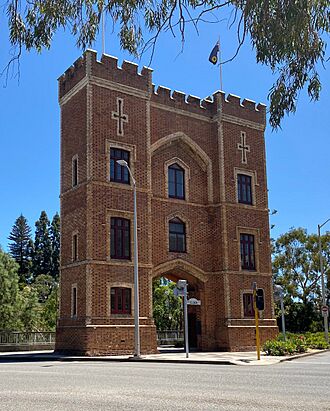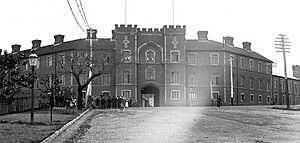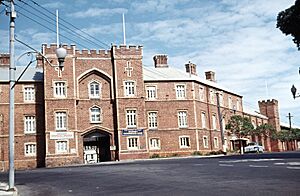Barracks Arch facts for kids
Quick facts for kids Barracks Arch |
|
|---|---|

The Barracks Arch in 2023
|
|
| General information | |
| Type | Heritage-listed building |
| Location | St Georges Terrace, Perth, Western Australia |
| Coordinates | Lua error in Module:Coordinates at line 614: attempt to index field 'wikibase' (a nil value). |
| Type | State Registered Place |
| Designated | 22 June 2001 |
| Reference no. | 2120 |
The Barracks Arch is a historic landmark in Perth, Western Australia. You can find it at the western end of St Georges Terrace, where Malcolm and Elder Streets meet. It's a cool reminder of Perth's past.
The Original Barracks Building
Who Built the Barracks?
A talented architect named Richard Roach Jewell designed the Barracks. It was built between 1863 and 1866. The building was made to house the Enrolled Pensioner Force. These were special guards.
What Was the Enrolled Pensioner Force?
These guards came to Australia on ships carrying convicts. They helped keep watch. In return, they received small pieces of land and part-time guard jobs. In the 1860s, most of the work involving convicts moved from Fremantle to Perth. This meant many Enrolled Pensioners and their families needed a place to live.
Design and Features of the Barracks
Architect Jewell designed the Barracks to look like a medieval castle. It had three stories and was built in a style called Tudor. The building was made of brick, which was cheaper than stone. It had pale bricks under the windows to create horizontal lines. The roof was made of timber shingles.
The Barracks was finished in 1866. Later, it was made bigger to house 21 more families. Each family had two rooms, about 4 by 3.3 meters (13 by 11 feet) each. Most rooms had a fireplace. Other buildings included a cookhouse, a firing range, a gun-room, a wash-house, stores, and stables. A "fives court" (a type of handball court) was added later.
Fire and Repairs
In 1887, a fire damaged the Barracks. It destroyed the wooden floors of the east wing and part of the central section. People formed a chain to pass buckets of water from the Swan River to fight the fire. The damaged parts were later rebuilt.
Changing Uses of the Barracks
From 1900 to 1904, the Barracks slowly became offices. It became the main office for the Public Works Department in 1904. Famous people worked there, like C. Y. O'Connor, whose office was right above the arch. The old fives court became a drawing office. It was later connected to a new building for the water supply department. The Public Works Department moved to a new building in 1966.
Saving the Barracks Arch
Plans for Demolition
After the government departments moved out, there were plans to tear down the Barracks. This was to make way for the Mitchell Freeway. Many people were upset about this. In 1961, a group called the Barracks Defence Council was formed. They wanted to save the building.
Public Opinion and Protests
In 1966, many people protested the demolition. The Barracks Defence Council wanted to save at least the arch and some windows. They hoped to keep the gateway and towers at the very least. While people protested, demolition work began. Some parts of the building were already torn down.
Voting to Save the Arch
To see what people thought, several polls were held.
- A radio station poll in March 1966 showed 2,747 votes to keep the arch and only 59 to demolish it.
- A newspaper poll in July showed 9,681 votes to keep it and 1,345 against.
- The government also did a poll. It showed 49% wanted to keep the arch, 35% wanted to demolish it, and 11% had no opinion.
The Premier at the time, David Brand, said the results were not clear enough. He decided that the parliament would vote on the arch's future. On October 19, 1966, the motion to demolish the arch was defeated. This meant the arch would stay!
Why Some Wanted to Demolish It
The Barracks Arch stands in front of Parliament House. Some people wanted to tear it down to create a clear view from Parliament House down St Georges Terrace. They also wanted a clear view of Parliament House from the street. This was a main reason for wanting to demolish it.
The Arch Today
After the vote, the Public Works Department kept the arch. They also made the area around it look nice. Over the years, plans have been made to keep the arch well-maintained and preserved. The fight to save the Barracks Arch was a big moment for groups who work to protect historical buildings. It showed that public opinion could make a difference.



